Centuries ago, Nebraska’s Pine Ridge and Chadron Creek made Chadron an ideal spot for trappers and fur traders. Indeed, in the Lakota language, Chadron is known as čhápa wakpá otȟúŋwahe, meaning “beaver river city”.
All this local history made it the perfect spot to establish the Museum of the Fur Trade.
The fur trade was North America’s first commercial industry. From the 16th century on, fur traders paddled the rivers, set up trading posts, and made alliances that changed changed history.
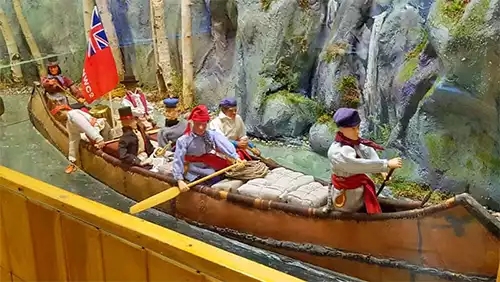
Visitors can step back through time into that history at The Museum of the Fur Trade in Chadron, Nebraska.
What’s in the Museum of the Fur Trade?
The Museum of the Fur Trade has been building its library and collection of artifacts — there are 6000+ primary objects — since 1949. It opened in Chadron in 1955 on the James Bordeaux Trading Post that had operated between 1837 and 1876.
Do you know who made the first maps of the Chadron area?
It was a time before maps — between 1804 and 1806 William Clark is credited with preparing 140 maps on the Lewis & Clarke journey across America. But they weren’t the first mapmakers. In fact, the museum also collected about 30 maps from earlier fur traders and trappers.
The first part of the museum, the Lindeken Exhibit Hall, celebrates the three centuries when the canoe men or the voyageurs followed North America’s rivers and streams into the interior.
Later, into the end of the 1800s, red river carts were used for overland transportation of the furs.
These were often built by the Metis (descendants of the voyageurs and their local wives), with iron bands for the wheels added by wheelwrights hired by the fur companies.
One of these carts could carry up to 800 or 900 pounds of trade goods, or furs, on the return trip.
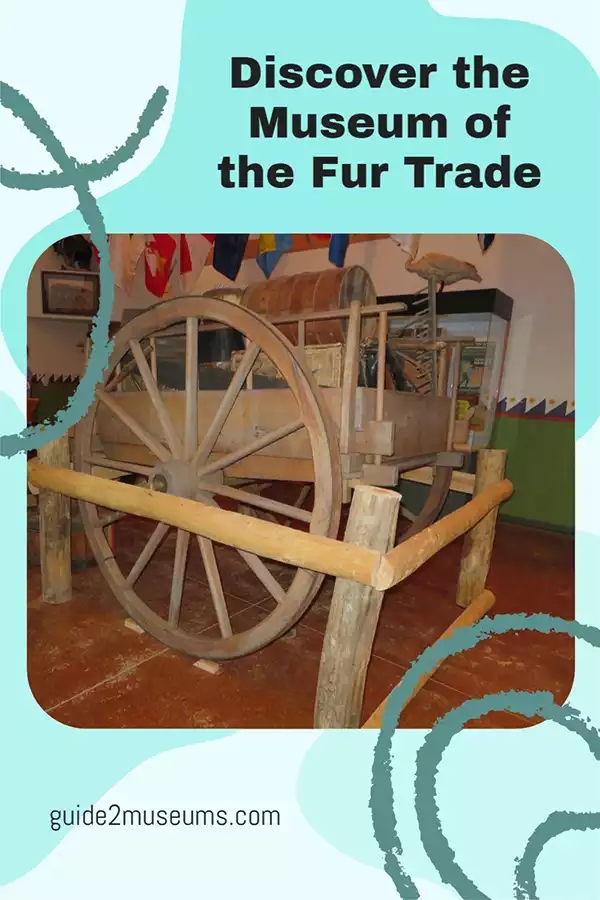
The museum has a beautiful replica of this transportation innovation on display.
Steerman Firearms Hall
The Museum of the Fur Trade has the largest, and most complete, collection of guns made specifically for trade with the early Indigenous inhabitants of the continent.
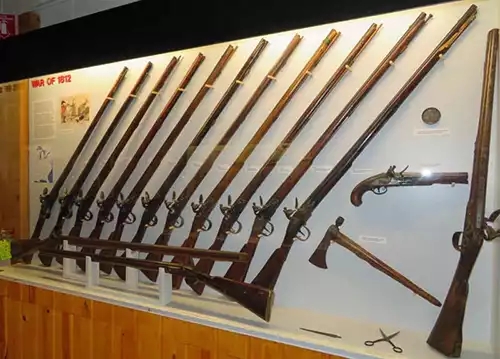
Many are simply named as Northwest guns, along with the years they were built.
Others include Hawken rifles, buffalo guns, even Remingtons.
The years on the info cards for each gun or rifle were enough to grab my attention!
In fact, the collection includes the earliest known intact trade gun, which was made in the Netherlands before 1650!
Trade Goods
Fur trading companies transported various goods to trade for furs with the local trappers. You can see many of them in the museum, as the collection includes a complete type set of goods sold by each nation operating as buyers in the area.
The museum also has some unique goods, such as:
- World’s most comprehensive collection of textiles traded during this era (Bevin B. and Maxine Bump Exhibit Hall)
- Bricks of compressed tea from Russia
- Twist of tobacco sold by the fathom
- Chinese vermillion body paint
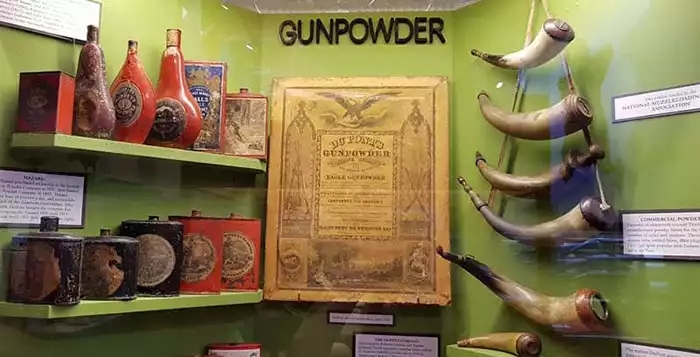
As well, the museum has an amazing collection of gunpowder and gunpowder horns. While I’d certainly read lots about gunpowder — and seen black powder rifles fired — I hadn’t expected the beautifully decorated tins and variously shaped horns traded to locals.
Linda’s Pick of the Exhibits
The Museum of the Fur Trade is located on the James Bordeaux Trading Post, which I found to be fascinating. While not the original building, the log cabin was reconstructed in 1956 on its original foundation stones.
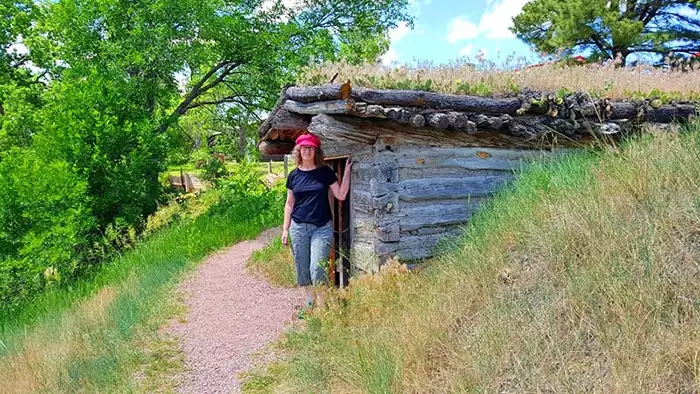
The trading post sits next to Bordeaux Creek, which was named for James Bordeaux, the fur trader who ran it during its peak years.
Other buildings include the Trade Room where the fur traders and trappers worked out their deals. What were things worth back then?
- Flintlock gun – 5 buffalo robes
- Medium blanket – 3 buffalo robes
- 5 yards of print cotton material – 1 buffalo robe
- 50 bullets 1 lb powder – 1 buffalo robe
Fast Fact: There’s also a robe press used to bale the buffalo robes. Each winter, the Bordeaux Post took in about a thousand tanned buffalo robes. When folded (hair to the inside), the robes measured 2 feet by 3 feet in size. Eastern buyers bought the robes for bed covers, and lab robes for traveling and coats.
The Heirloom Indian Garden was also outside. Grown from seeds collected over a century-and-a-quarter ago by a Dakota horticulturist, Oscar Will, the crops include midget Mandan tobacco, Assiniboin flint corn, and blue-kernelled little corn.
Linda’s Reflections
I thought I knew a lot about the fur trade until I visited the Museum of the Fur Trade. Was I ever wrong!
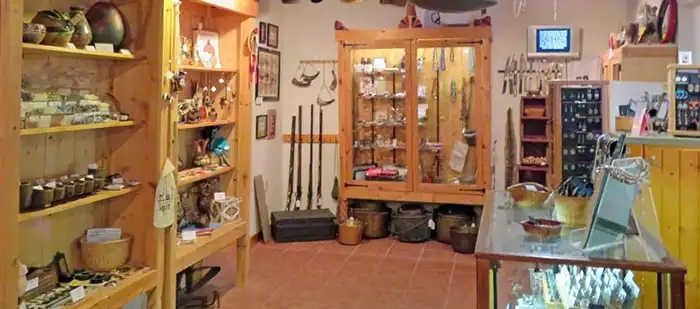
In fact, the foundation of the museum is in its library and research program. Their library has about 10,000 volumes on the fur trade and related topics. They also have hundreds of rolls of microfilm of fur company records.
My knowledge of the fur trade revolved around Canada’s Hudson’s Bay Company and The Northwest Company. What I’d missed covered the globe, as the fur trade was carried on from Greenland to Alaska and Hudson’s Bay to the Gulf of Mexico. That’s a lot of territory.
And all of it’s part of the Museum’s research.
Who Should Visit the Museum of the Fur Trade?
The great plains of western Nebraska are a fascinating spot to visit for anyone interested in the exploration of the West, the fur trade, and later, the era of cowboys and cattle drives.
As well as four exhibit halls and a museum shop inside the white-plastered central building, there are a number of outside exhibits.
Fast Fact: Due to the nature of the goods exchanged between European fur traders and locals, the museum provides hard-to-find examples of objects like early textiles, blankets, cookware, and of course, guns and gunpowder.
All ages will find something interesting!
Linda’s Road Trip Tips
I spent a week in Western Nebraska, exploring its many attractions. On this part of the journey, I overnighted in Chadron at the Monument Inn & Suites, which was very comfortable.
I enjoyed a dinner of Lamb breast with roasted sunchokes, rosemary, and preserve lemon at the Emporium Coffeehouse, which was just a few miles from Chadron. Dessert was strawberry shortcake with whipped creme fraiche. Yum!
The next day, I toured Fort Robinson State Park, as well as the Mari Sandoz Heritage Center in Chadron.
How Do You Visit the Fur Trade Museum?
Best Time to Visit: The city of Chadron and surrounding areas celebrate their history every July with Fur Trade Days. It’s a celebration that brings a midway, entertainment, fireworks, a parade, family-friendly activities, a buckskinner’s camp, and of course, a trader’s market.
Address: 6321 US-20, Chadron, Nebraska.
Start your trip with Google maps.
Learn more about Museum of the Fur Trade open days and hours on the Web. Check before you visit as the museum is open seasonally from May through October, and only by appointment the rest of the year.
Explore More History Museums
- Compelling NC History at Museum of New South
 The Levine Museum of the New South in Charlotte, North Carolina, focuses on changing exhibits that foster empathy, ignite dialog, and inspire action. It aims to create a stronger, more equitable community.
The Levine Museum of the New South in Charlotte, North Carolina, focuses on changing exhibits that foster empathy, ignite dialog, and inspire action. It aims to create a stronger, more equitable community. - 1860s Dolls to Local Legends: Texas Museum
 The Jefferson Historical Museum in Jefferson, Texas, preserves the town’s heritage as a bustling riverport town. It’s located in the town’s original 1888 Post Office and Federal Court House.
The Jefferson Historical Museum in Jefferson, Texas, preserves the town’s heritage as a bustling riverport town. It’s located in the town’s original 1888 Post Office and Federal Court House. - Eye-Opening Museum of the Fur Trade: NE
 The Museum of the Fur Trade has a collection of over 6000 primary objects and a 10,000 volume library. Extensive amounts of information are provided with the objects.
The Museum of the Fur Trade has a collection of over 6000 primary objects and a 10,000 volume library. Extensive amounts of information are provided with the objects. - Rich Lifestyles in 1880s Saskatchewan – Historic Site
 Discover how young English squires lived, while pioneers were breaking the land, with a visit to Cannington Manor. There’s a small museum as well as restored site buildings.
Discover how young English squires lived, while pioneers were breaking the land, with a visit to Cannington Manor. There’s a small museum as well as restored site buildings. - Fascinating Mystic Seaport Museum: Connecticut
 The Mystic Seaport is a maritime museum dedicated to the history of whaling. Its impressive ship collection includes the Charles W. Morgan last wooden whaleship in the world.
The Mystic Seaport is a maritime museum dedicated to the history of whaling. Its impressive ship collection includes the Charles W. Morgan last wooden whaleship in the world. - World’s Largest Bulldozer to a D-Day Plane in ND Museum
 The open air museum, Bonanzaville, in Fargo, North Dakota, has 43 historic buildings. It contains typical rural & agricultural exhibits with some extras.
The open air museum, Bonanzaville, in Fargo, North Dakota, has 43 historic buildings. It contains typical rural & agricultural exhibits with some extras. - Old West Lives Again in a Montana Museum
 Visit the Range Riders Museum in Miles City, Montana, for a real old west experience. Created by working cowboys, it tells the story of the West.
Visit the Range Riders Museum in Miles City, Montana, for a real old west experience. Created by working cowboys, it tells the story of the West.
Acknowledgements
I visited the Museum of the Fur Trade on a press trip hosted by the Nebraska Tourism Commission and local CVBs. While I was hosted, I retain full editorial control of the articles I write after taking this trip.









